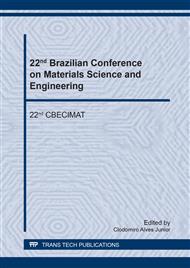p.434
p.440
p.445
p.449
p.454
p.460
p.466
p.472
p.478
Recycling Chips of Stainless Steel by High Energy Ball Milling
Abstract:
Stainless steel components produced by powder metallurgy constitute an important and growing segment of the industry. The high energy ball milling process can be an alternative for the recycling of the stainless steel chips. A major advantage of stainless steel is its ability to be recyclable. The reuse of recyclable materials has as main objectives to minimize the environmental impacts and to rationalize the use of the energy chains. This work aims at the production of stainless steel, starting from machining chips pure, and with the addition of vanadium carbides by high energy planetary milling with ball to powder weight ratio 20:1, and mill speed of 350 rpm milled in argon atmosphere for 50h. The compaction of stainless steel samples with vanadium carbide was made in a cylindrical matrix at a pressure of 700 Mpa. The sintering process was performed in a vacuum atmosphere furnace at a temperature of 1200 ° C for 1h. Through the milling process with the addition of carbide it was possible to produce stainless steel powder with a mean particle size of 49 μm. By X-ray diffraction was observed the appearance of the ferritic, austenitic phase and the martensitic phase induced by deformation phase that remained even after the sintering. The density of the sintered material is around 77% of the melt, and the obtained porosity was low.
Info:
Periodical:
Pages:
454-459
Citation:
Online since:
September 2018
Keywords:
Price:
Сopyright:
© 2018 Trans Tech Publications Ltd. All Rights Reserved
Share:
Citation:


